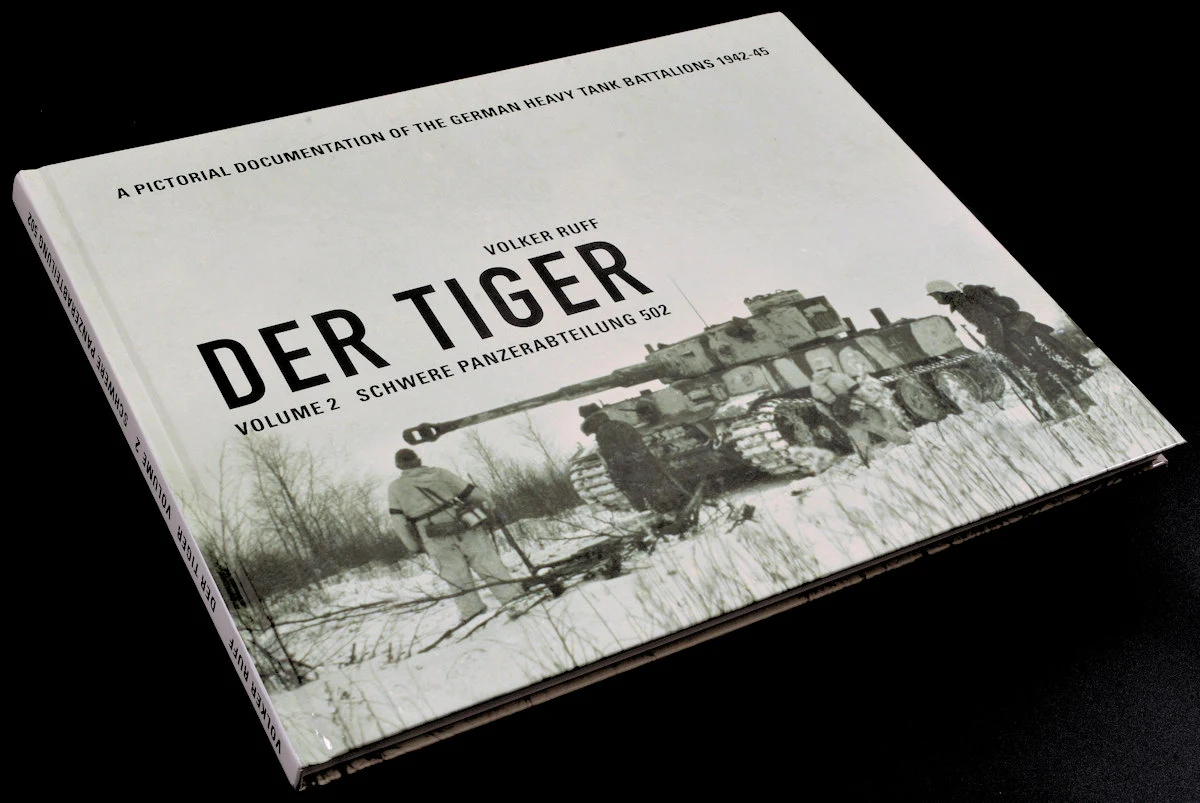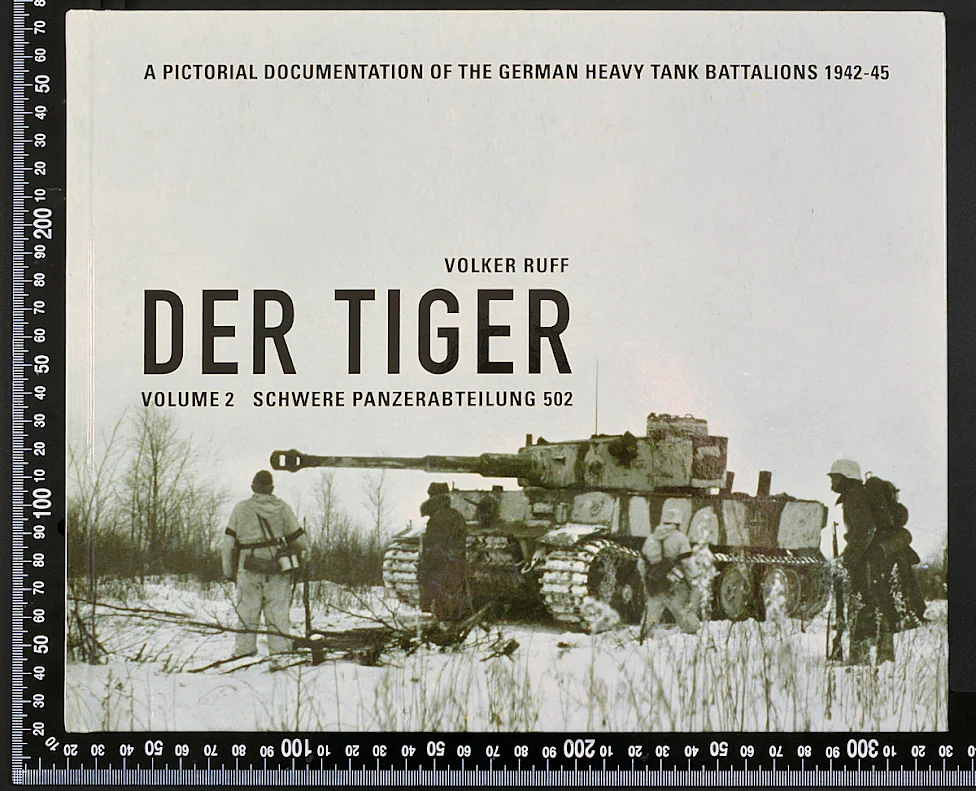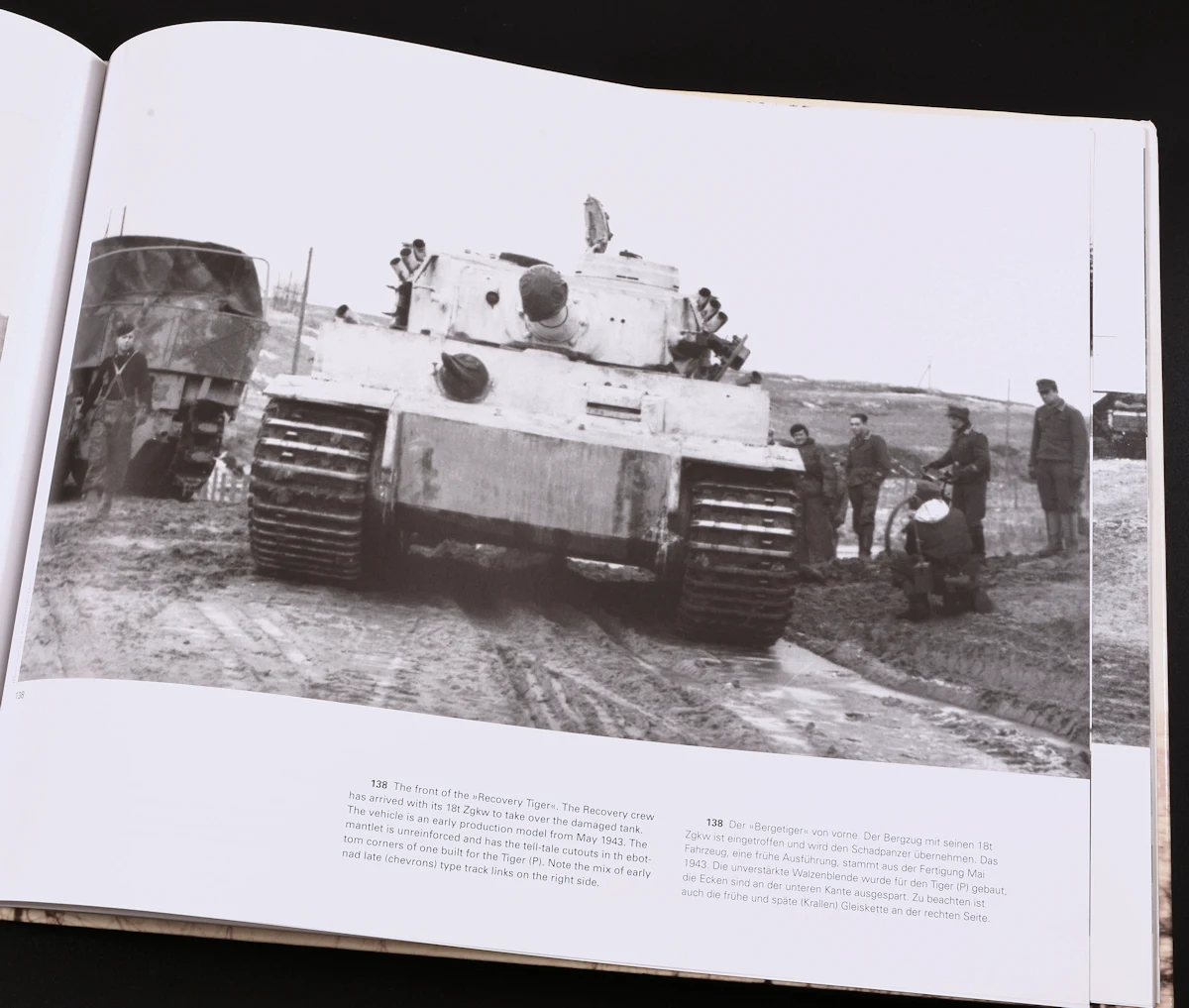Volker Ruff's new book "Der Tiger, Volume 2 ...Schwere Panzerabteilung 502" sees this unit's history with the Tiger I from 1942 in the early days of the battle of Leningrad 'till the end of the war near the Baltic Sea. We were pretty keen to bring you a review of this book that focuses on the Tiger I. See what we thought after we gave it a read...
Der Tiger, Volume 2 ...Schwere Panzerabteilung 502
A pictorial Documentation of the German Heavy Tank Battalions 1942-45
By Volker Ruff
Language: English/German texts
No of Photos: 100+
No of Pages: 128
Format: Hardcover, 300 x 245mm, landscape format
ISBN: 978-3-9816908-1-1
Pice £26.99
Postage UK: Free Europe: £9.00/ Rest of World: £13.90 OZ: £15.05
We got to see a buddy's copy of "Der Tiger" by Volker Ruff, it was full of some of the most interesting photos and info on one of my favourite tanks (I'm probably not alone) the Tiger I. When we found out that the second volume was out – and that it followed Abt. 502's journey through the war, well who were we to say we don't want to read it?
For those not familiar with this series (a third book is planned for later this year) the format is a hardcover book in a wide landscape format in roughly A4 (300 x 245mm) size. Inside is one hundred and twenty-eight pages, of a thick nice white stock, with some mostly large pictures inside and English/ German dual text explaining what is in the page. The nature of the book is one of a chronological storyline of pictures and text to support it...
Contents of this volume.
...also helpful are the glossary of the German terms for some of the words in the book
The pictures inside are of a pretty good quality usually. Volker explains that the smaller and lesser quality pictures were included for their unique attributes or interest. This is fair enough, though the full page photos when they are in the book are very nice to see and that is why the book is laid out in landscape I suppose. The writing is of a complementary nature rather than a story narrative. The paragraphs/ captions are there to support when/ where and the insightful points of each of the Tigers in the pictures, often noting slight changes to the vehicles as time and variants of the tiger I progressed.
The s.Pz.Abt.502 was the first tank unit deployed with the Tiger I, and the tank saw action in the company in a variety of fronts and actions. These are all logged in turn as we go through the book. From Leningrad Ladoga area at the end of August 1942, from the Ladoga battles, Baltic area Narwa, Pleskau, Dünaburg and Newel pocket in 1944, these are all here with pictures (over one hundred) that I had not seen before, but I am sure they will be used for a bit of modelling inspiration by someone looking for new or fresh ideas for their diorama.
OK, enough talk ABOUT the book – let's go thru it from cover to cover to really let you know what's inside...
The first real chapter of this book mirrors what we will see throughout this book. Each chapter is broken up into several parts, each of the places and actions captures are featured on two, three, four, five or six or so pages of pictures and captions. The operations in Autumn/ Winter 1942/43 are featured here in the first thirty-eight pages. We see the how the Tiger I developed as they go through their first paces in action. How the tanks adopt the newer parts developed for it are shown in the many pictures (along with some non-tiger pictures like the Pz .III.)
We also see some Tigers being repaired, their grey and white camouflage are of note here, and the snowy forests and flats, the white-striped tigers and troops dressed in white with not much light around really make the scenes look cold and these few tanks the unit had at that time certainly seemed to work hard. The familiar chassis coming up in several of the pages chart the use and abuse the terrain and constant use had on them. Several Tigers are here stuck in rivers, on the side of the road in a crater or simply broken down.
Through this book, there are small tables that show unit strength and operational capability of the Abt.502
The second chapter of about eight pages sees the 502nd in February 1943 getting replacement/ additional tigers to the unit at the base at Tossino. We see more of the author telling us how these tigers varied and pointing out these features on these images. It quickly educates you on the evolution of the tanks as we look at it chronologically. I like this aspect of the book. We see the progress in these images right through the book. The other thing we see is the change of seasons in the passage of time and actions fought. It is there as the snow in the tracks of the Tigers and the ground turns to thick mud and soil in this chapter. Wear and tear on whitewashed vehicles is prominent and a handy tip for the modeller. As the ground hardens we see tigers in their repair depots undergoing maintenance.
The third chapter starts in March-thru-June 1943, as we see the tigers in again better terrain in Brittany to complete the formation of the unit. Mud and sleet changes to grass and trees as the thirty-one extra Tigers and their crews underwent familiarisation and training in rural France. These big cats are seen in manoeuvres in the grounds of a large chateau. The crews from the three parts of the 502 working out the details of, and how to solve the issues brought about by the use of such a new vehicle are all pointed out by the author, as well as notes like when the unit got it's "Mammut" markings and turret numbers assigned. Lots of fresh faces on the crews and nice uniforms on display here.
Summer in 1943 sees the unit back in action in the Lake Ladoga area fighting the Russians trying to break back through to Leningrad. Of interest here is a bogged Tiger with a PK cameraman in a great shot, a Tiger schlepping ammunition for the artillery (wow) and another on a railway car without its transport tracks fitted.
Halfway through the book, we see the unit in the extremely hard fighting and heavy losses incurred in the third battle of Lake Ladoga in June 1943. More pictures here of Tigers actually fighting and nearer the enemy are a great addition as we get more information on the singular tanks particulars again from the author. There are a few series of shots in this book, like the tigers lining up for ammunition and returning to the front in a cloud of dust. After the battle, we see lots of Tigers being hauled back to repair shops in the rear. In these pages, we learn about the skids that were used to recover the Tigers with broken tracks or suspension here in a diagram as well as pictures. There are plenty of pictures of Tiger Nr.311 giving you a lot of reference on this vehicle.
Page 86 – the Defences near Nevel in 1943/44 is the next chapter of about twenty-four pages, and it is already October on the front lines with Abt. 502. the first series of images in this chapter sees Tigers before the battle, with their crews either resting, smoking, eating or checking their vehicles mechanical problems. A further series of shots in sequence shows a unit meeting at some farmhouses, receiving orders and moving out. This is a great series for those thinking of planning a diorama.
All of a sudden it is November, and the ground is back to a blanket of white snow and the Abt is on the defensive yet again, this time around the strategic hill 204 which provides us again with a series of photos from PK cameramen with the captions of the time included as well as a contemporary explanation of the scene. We see bridging engineers in several photos making the frail river crossings in some parts of the front able to take the 56 tonne Tigers, as well as some (rare) pictures of a Tiger pulling another from the water – as this was only allowed in severe circumstances we learn here.
February 1944 and the unit received new tigers, the changes are shown again in pictures and text, with the markings or lack of them and the general notable features of each of the tanks pictures noted here. I like how the author's knowledge comes through this text to suppose the transition of some of the tanks and what has changed on them, or when they may have entered service and in what incarnation by the photographic evidence shown here. Even though it is getting on into spring, several of the tanks still wear their winter camouflages which are heavily beaten and worn away.
Summer in 1944 comes near the end of the book as the Russians launch operation Bagration. The whole front broke, and Abt.502 saw itself retreating all the way to the Riga area where we see the Tigers on railcars and then as part of a rearguard "firefighting" against the advancing Russians in the Courland area.
The last pages of this book see the unit transfer to Tiger II's. The last two pages show the fate of some of their mounts. A sad way for this proud kompanie to end the war.
There it is – 160 odd pictures in 128 pages, and I am a whole lot more educated on the TigerI, and even more so of the Abt.502. This unit's journey through the war in these Tiger I's is really well portrayed by the chronological all in one journey in these pictures.
The captions and the author's great insight into the subject are transferred to the reader by reading the book through osmosis as you read about these vehicles, some you see at different points of the book, and some the author tells you about their journey behind the scenes of the pages.
Those wanting a concise unit history will find this book only supplemental in the text department, but in the pictures and the inspiration, this book scores high points in my view. I am really interested in the third volume now – apparently out in November. I know I'll be waiting...
Adam Norenberg
Thanks to Panzerwrecks for sending this book to me to read and review.


















